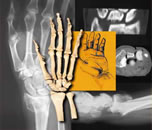After reviewing the plain radiographs, the patient was
sent for CT scans of both wrists.
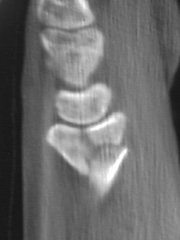 |
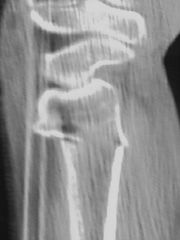 |
Fig 4 CT sagittal
views of left wrist |
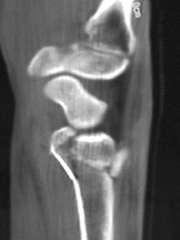 |
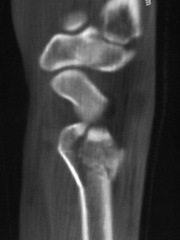 |
Fig 6 CT scan
of right wrist |
The CT scans showed intraarticular fractures of both distal
radii, as well as significant comminution. After discussion with the
patient, she had open reduction and internal fixation of both wrists
approximately one week apart. The left wrist was operated on first.
In the operating room, the fracture was reduced and a dorsal T-plate
was applied. The following week, the right distal radius underwent a
volar open reduction with placement of a buttress plate. Bone grafting
was not performed in either fracture. Post operatively, the regimen
was identical for each fracture. Digital motion was begun on the first
postoperative day. The initial operative splint was removed two weeks
after surgery. The patient was placed in custom molded, removable wrist
control splints. She began gentle active motion of the wrist (flexion/extension
and pronation/supination) with the therapists three times per week.
Six weeks (right wrist) and seven weeks (left wrist) postoperatively,
radiographs were taken which revealed fracture healing. The patient
was then instructed to wean herself from the splints over the following
two to three weeks. At nine and ten weeks after surgery for the right
and left wrists, respectively, she had discontinued the use of splints.
Her wrist motion on the right is: flex/ext=37/55, pro/sup=75/80; motion
on the left is: flex/ext=40/60, pro/sup=70/55.
Open reduction and internal fixation was chosen to allow
early motion of the wrist. A dorsal plate was chosen for the left wrist
because of the displacement of the intraarticular component of the fracture
combined with dorsal angulation and metaphyseal comminution. The plate
serves as a buttress against dorsal angulation with a single radial
styloid screw in the largest of the distal fragments for additional
support.
The right wrist is a comminuted variant of the chauffeur's
fracture with volar displacement of the articular fragment. The volar
fragments were held together by periosteum, which was left intact. The
plate was used to buttress the volar fragments after reduction.
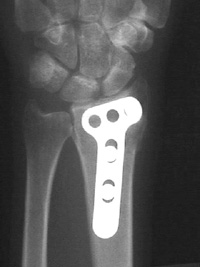
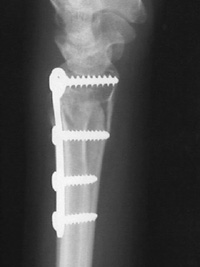
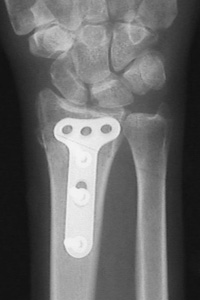
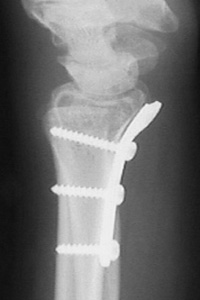
For discussion of this case, click on Forum (below), then
look under Guest Professor, and click on Case 3: Bilateral Fractures.
